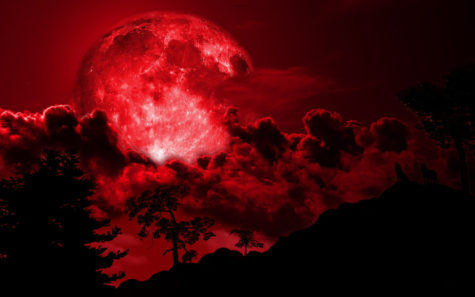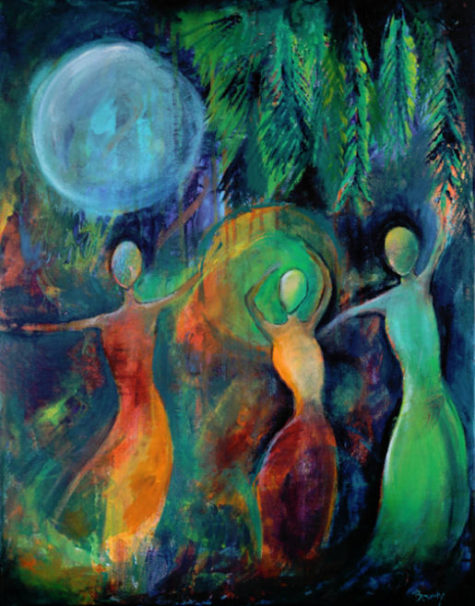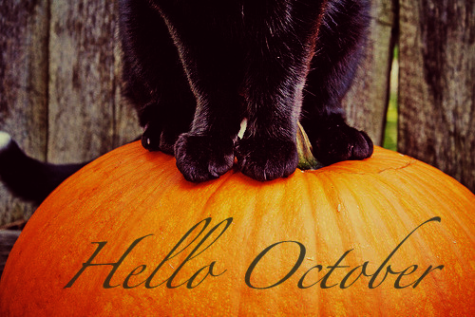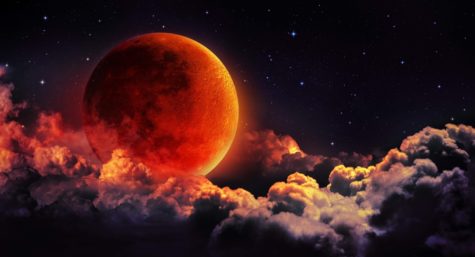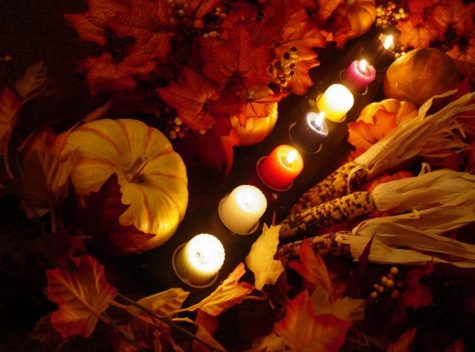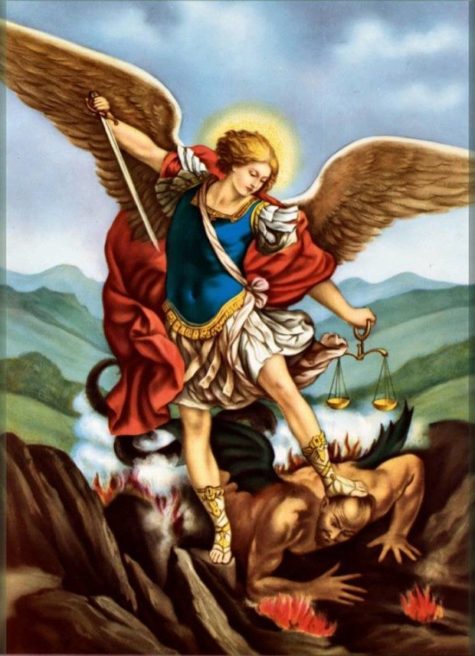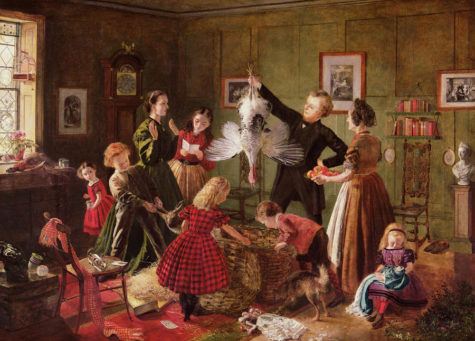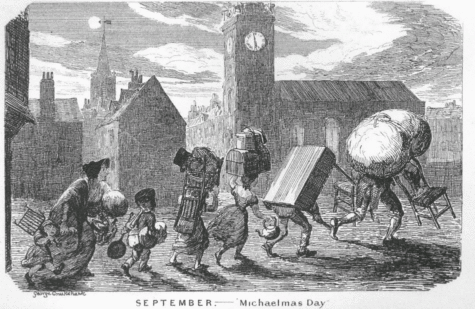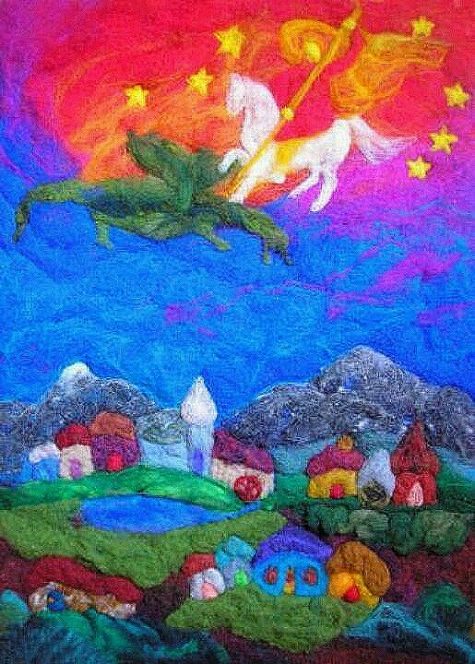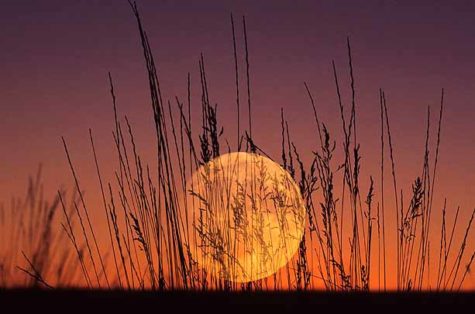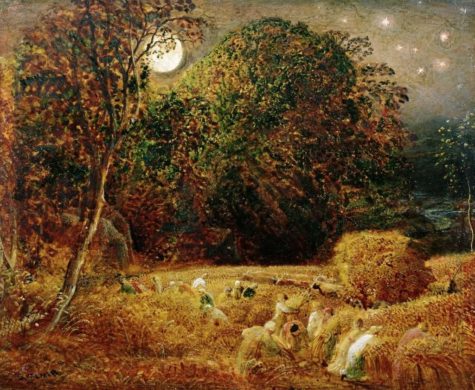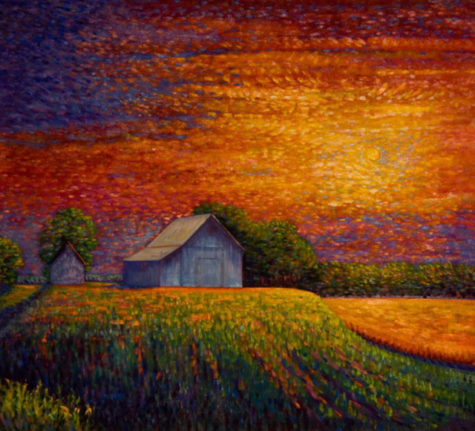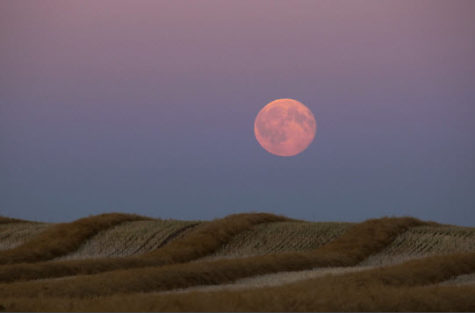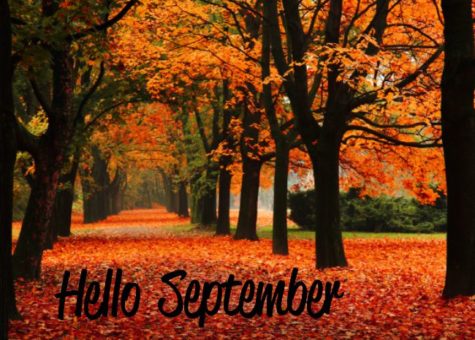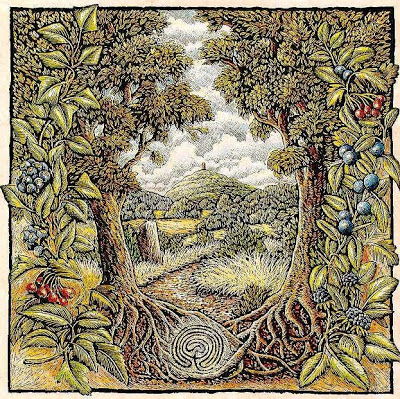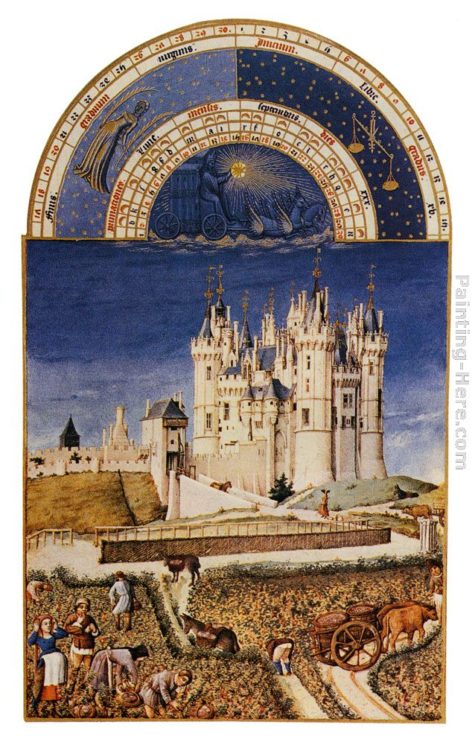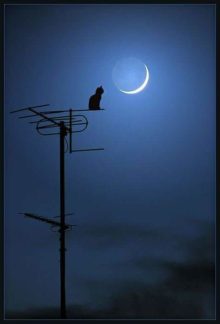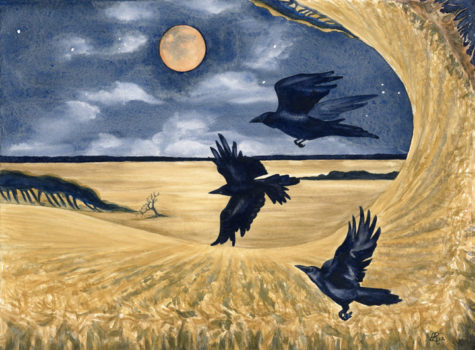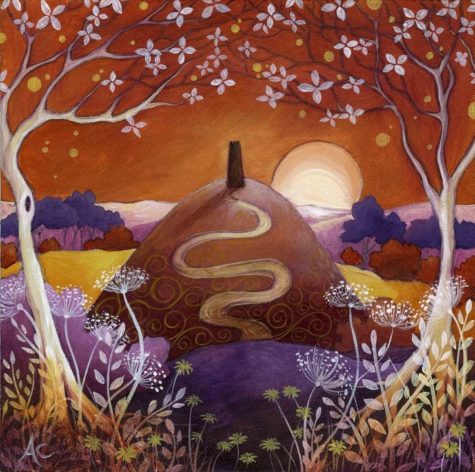Folklore
October’s full moon is often referred to as the Blood Moon, or Sanguine Moon. The Blood Moon takes its name not from blood sacrifices, but from the old custom of killing and salting down livestock before the Winter months made it impossible to feed them. Only the choicest stock was kept through the cold season.
The leaves are falling from trees, the deer are fattened, and it’s time to begin storing up meat for the long winter ahead. Because the fields were traditionally reaped in late September or early October, hunters could easily see fox and other animals that come out to glean from the fallen grains.
Coming right before Samhain, it’s a time when the nights are crisp and clear, and you can sense a change in the energy around you.
Correspondences:
- Colors: Dark blue, black, purples, Deep Blue Green
- Element: Air
- Scents: strawberry, apple blossom, and cherry
- Gemstones: Obsidian, amethyst, tourmaline, opal, beryl, turquoise
- Herbs: Apple blossom, pennyroyal, mint family, catnip, Sweet Annie, thyme, catnip, uva ursi, angelica, burdock
- Flowers: Calendula, marigold, cosmos
- Trees: Apples, yew, cypress, acacia
- Birds: Heron, crow, and robin
- Animals: Stag, jackal, elephant, ram, scorpion
- Nature Spirits: Frost and plant faeries
- Gods: Herne, Apollo, Cernunnos, Mercury, Ishtar, Astarte, Demeter, Kore, Lakshmi, The Horned God, Belili, Hathor
- Powers/Advice: A time to work on inner cleansing, letting go karma, reincarnation, justice and balance.
This is the time when the veil between our world and the spirit world are at its thinnest. Use this time for spiritual growth — if there’s a deceased ancestor you wish to contact, this is a great month to do it. Hold a séance, work on your divination, and pay attention to messages you get in your dreams.
Probably because of the threat of winter looming close, the Blood Moon is generally accorded with special honor, historically serving as an important feast day in both Western Europe and among many Native American tribes.
The Blood moon focuses around connecting with animals, and our animal totems and guides. Those who practice looking at the degrees of the lunar cycle may realize that this is the last time the moon will be at a later degree. This conjunction will allow many to look at life differently every time the new moon approaches and allowing us to look at past and the future at the same time.
This moon also forces us to look at love completely differently and ask the questions:
- What is love?
- Is the love you have unconditional?
That love does not have to be just in the areas of relationship but also our interaction with people, it can even be love of work and things you have acquired.
Additionally it means to be able to let it go of someone or something no matter how much you love it because it needs to be set free. The past years have reminded us that changes need to happen that this kind of life is no longer tolerant and peaceful. We will be reminded once again we can no longer walk in other people’s shadows.
Because this moon focuses around our animal nature, some of us may become very aggressive in what we say or do. It may cause many people to act out. This type of moon has been known for violence, suicides and domestic disputes over things that may or not exist – another reason it is known as the blood moon.
A Ritual For The Blood Moon
Here’s a nice little ritual to do for the Blood Moon.
You will need:
- A special glass or chalice – something pretty
- Rose water – or spring water
- White cotton cloth
- Red wine
- Ripe pomegranate
- Honey
- Silver spoon
For this ritual it will be nice to dress up a little. Wear white or silver, and if you have it, silver jewelry with carnelian, or moonstone. Use a special glass or chalice.
Rinse the chalice with rose water and dry it with a clean white cotton cloth. Pour the cup of red wine into the chalice, slice the pomegranate in half and squeeze the juice into the wine. Add a teaspoon of honey, and stir with the silver spoon.
Go outside. If you are doing this with friends, form a circle. Lift the chalice in the direction of the moon and say a few words of praise, thanks, appreciation, whatever feels appropriate and right. Then take a sip of the wine and pass the chalice clockwise around the circle (if there is one). Each person “toasts” the Blood Moon and drinks.
When the circle is complete, pour the rest of the wine on the ground as a “libation” or offering to the earth.
Collected from various sources including: PaganWiccan.About.Com, Art by Beverly Ash Gilbert.
In the ancient Roman calendar, October was the name of the eighth month of the year. Its name comes from octo, the Latin word for “eight.” When the Romans converted to a 12-month calendar, they tried to rename this month after various Roman emperors, but the name October stuck.
In Old England, the month was called Winmonath, which means “wine month,” for this was the time of year when wine was made. The English also called it Winterfylleth, or “Winter Full Moon.” They considered this full Moon to be the start of winter.
October Weather
A warm October is said to be a sign of a cold February. If leaves wither on the trees and fail to fall to the ground in autumn, it indicates a frosty winter with a great deal of snow, alternatively:
“If October brings heavy frosts and winds,
then will January and February be mild.”
The October Moons
The full moon closest to the Autumn Equinox is called the Harvest Moon, and as such, it sometimes falls in October. This moon is also called the Blood Moon, Hunters Moon, Shedding Moon or the Falling Leaf Moon. Coming right before Samhain, it’s a time when the nights are crisp and clear, and you can sense a change in the energy around you.
The Blood Moon takes its name not from blood sacrifices, but from the old custom of killing and salting down livestock before the Winter months made it impossible to feed them. Only the choicest stock was kept through the cold season.
Today we still subconsciously begin to make preparations for the coming Winter during this time. We check the antifreeze and tires for the car, gather up garden hoses, and make plans to winterize any drafty spots around doors and windows in the house. Some of us do and an ambitious fall cleaning.
October Magick
Throughout this month, festivals for the dead increase with the waning light, and late harvest festivals continue. The latter often include propitiation to ensure that the Goddess’s abundance will keep people whole through harsh or barren times.
Magical efforts accentuated by October’s characteristics include clearing away old, unnecessary things or habits so that our mind, body, and spirit are prepared for winter. Any spells for memory, especially commemorating loved ones, are apt. Beyond this, metaphysical efforts for health, luck, and debt paying seem common, ensuring that winter, the season of rest and death, will come and go with the least negative effect.
October Festivities
The Greek festival of Thesmophoria came every year in honor of Demeter and was confined to women only. This was a three-day rememberance of Kores return to the Underworld. At this festival the initiates shared a sacred barley drink and cakes. One feature of the Thesmophoria was a deterrent to offenders against the sacred laws against women. Priestesses read a list of the offenders before the doors of the goddesses’ temples, especially the temples of Demeter and Artemis. It was believed that anyone so cursed would die before the year ended.
The first day of the Thesmophoria was the kathodos, a ritual where purified priestesses took sacrificed piglets deep into the chasm where the sacred inner shrine of Demeter was. They left the piglets there and retrieved the remains of the one from the previous year. The second day was Nesteia, during which the remains of the retrieved piglets were displayed on the altar. Courts were closed in honor of Demeter as law-giver. On the third day, the retieved piglets were sown into the plowed Earth as a symbol of Demeter’s fertility aspect.
The Greeks also honored the god Hephaestus with an annual festival called Chalkeia.
In Tibet, the Buddhist Lent occured along with the Descent from Heaven festival which celebrated the end of the rainy season.
The Durga Puja in India honors the goddess Durga for four days beginning on the New Moon. It is a time of family reuntions, settling quarrels, and honoring the parents. In northern India this fesival is known as Dasahara. Durga is considered a matriarchal figure and is very popular with the people. She is shown with many arms and in bright colors.
The Lakshmi Puja, or Diwalii, is a fest of lights in honor of the goddess Lakshmi. It occurs right after the Durga Puja. During this Festival of Lights, lamos are everywhere, good things to eat are produced, and Hindu wives dance for their husbands. Lakshmi, wife of Vishnu, is considered the goddess of wealth and prosperity.
In the Pacific Ocean, the ancient Hawaiians celebrated a four-month long festival called Makahiki, beginning of the first Full Moon of this month. The god Lono had a special celebration of five days during this time, filled with games, pageantry, the hula, surfing, feasting, and tax collecting.
From:
September 29th is a medieval holiday which the Church Christianized under the label of “Michaelmas,” a feast in honor of the Archangel Michael. It is thought that the Roman Catholic Church at some point considered assigning the quarter dates to the four Archangels, since they had assigned the cross quarters to the four gospel-writers.
The feast day of St. Michael, the archangel and overcomer of the Devil, is a Christian celebration. Its main importance in people’s lives was that of a seasonal signpost in the year. In the British Isles, crops were harvested and the surplus sold by late September, so this became the time when farmers would pay their yearly rents to landowners.
Everyone ate goose at Michaelmas to bring prosperity, and many farmers included “a goose fit for the lord’s dinner” with their rent payments. Great market fairs occurred just before the feast day, and the large crowds these attracted made it convenient to hold elections at this time. Michaelmas is also a “Quarter Day.”
The ancient Celtic people divided the year into four major sections, or quarters, and then divided each of these in half to make an eight-part year that reflected the natural progression of the seasons. Foods traditional for Michaelmas include new wine; goose; cakes of oats, barley, and rye; and carrots. Some groups in the United States, such as the Pennsylvania Dutch, have kept Michaelmas, or “Harvest Home,” traditions alive.
During the Middle Ages, Michaelmas was celebrated as a Holy Day of Obligation, but this tradition was abolished in the 18th century. Lutheran Christians consider it a principal feast of Christ.
It was also one of the Welsh and Irish quarter days when accounts had to be settled. On manors, it was the day when a reeve was elected from the peasants. Traditional meal for the day includes goose (a “stubble-goose”, i.e. one prepared around harvest time) and a special cake called a St Michael’s bannock.
A Note About Dates:
There is evidence that Michaelmas was once celebrated later in the year, on the 10th or 11th of October, this is now referred to as ‘Old Michaelmas Day’. There may also have been a time when both dates for Michaelmas were acknowledged.
I like the legend of teenage girls collecting crab apples at the beginning of September, and arranging them in the initials of boys they fancied. If they could still discern the initials on Old Michaelmas Day, then then true love and romance would follow. The legend conjures two unrelated thoughts in my mind, firstly, would other girls mischievously re-arrange the apples to form the initials of a different boy. Secondly, what is the modern equivalent of this courtship ritual?
It’s interesting that certain customs transfer from one season to another. For example, two people snapping the the Michaelmas goose’s wishbone and thinking of a secret desire. Also, the concept of a Michaelmas Pie with ring, according to this legend, the lucky recipient will be engaged by Christmas and marry by Easter. Variations on these themes occur at Christmas and possibly at Thanksgiving.
Michaelmas Customs and Lore
According to an old legend, blackberries should not be picked after this date.
This is because, so folklore goes, Satan was banished from Heaven on this day, fell into a blackberry bush and cursed the brambles as he fell into them. In Yorkshire, it is said that the devil had spat on them. This old legend is well known in all parts of the United Kingdom, even as far north as the Orkney Islands. In Cornwall, a similar legend prevails, however, the saying goes that the devil urinated on them.
This is one Michaelmas custom that survives to this day, although sometimes it is said that you should not eat blackberries after the 29th of September. There is a very good reason for this custom, namely that by this time of year blackberries are tasteless and watery.
Other fruits, particularly nuts and rose-hips also have customs associated with Michaelmas. For example, ‘Hipping Day’ in Yorkshire, or Michaelmas pie in Ireland (Made of apples).
- Mop Fairs (Hiring Time):
Michaelmas was traditionally time when laborers and servants were hired. As the name suggests, maids would carry mops, but other trades carried the tools of their trades.
Thus the squires or the lord’s of the manor could tell what skills the prospective employees had, for example, a Shepherds his crook, and a gardener a rake.
- Fishing:
Michaelmas marks the end of the fishing season.
- Curfew:
The start of the curfew for winter night nights. The local church bell sounded each night from Michaelmas until lent. Curfew is derived from the French phrase ‘courve feu’, which means to cover, or to dowse a fire.
- Rent:
When tenants came to pay their quarter’s rent, they bring a fowl at Midsummer, a dish of fish in Lent, a capon at Christmas, and on Michaelmas Day, a goose.
- Trees:
This is traditionally a good time to plant trees as evidenced by this old saying, “A Tree planted at Michaelmas, will surely not go amiss.”
More Michaelmas Lore:
At Michaelmas time, or a little before,
Half an apple goes to the core;
At Christmas time, or a little after,
A crab in the hedge, and thanks to the rafter.
- If you eat goose on Michaelmas Day, you will not be short of money all year round.
- A Michaelmas rot comes ne’er in the pot.
- If St Michael brings many acorns, Christmas will cover the fields with snow.
- Michaelmas chickens and parsons’ daughters never come to good.
- Three things that never come to any good: Christmas pigs, Michaelmas fowls, and parsons’ daughters.
- So many days the moon is old on St Michael’s day, so many floods after.
- Harvest comes as long before Michaelmas as dog roses bloom before Midsummer.
- On Michaelmas Day the devil puts his foot on the blackberries.
- St Michael’s rain does not stay long in the sky.
- If it does not rain on St Michael’s and Gallus [Oct 16], a dry spring is indicated for the next year.
Collected from a variety of sources
The Full Moon in September is all about emotions, healing, and balancing. This is a time of organizing and preparing for the coming months.
“This powerful Gateway is an opportunity to greatly accelerate your spiritual growth and to promote Balance in your life. Divine Masculine supports the Divine Feminine. As they come together in Sacred Marriage, you realize that one without the other is not balanced. So, do not act unless it is aligned with your Integrity; your Heart. Be inspired and then take a step toward your dream.”
– Ascension: Soulstice Rising
The Farmer’s Almanac tells us that this full moon’s name is the Full Corn Moon, attributed to Native Americans because it marked when corn was supposed to be harvested, however some calendars attribute the Corn Moon to the month of August. Most often, the September full moon is actually the Harvest Moon, which is the full Moon that occurs closest to the autumn equinox.
In two years out of three, the Harvest Moon comes in September, but in some years it occurs in October. At the peak of harvest, farmers can work late into the night by the light of this Moon. Usually the full moon rises an average of 50 minutes later each night, but for the few nights around the Harvest Moon, the Moon seems to rise at nearly the same time each night: just 25 to 30 minutes later across the U.S., and only 10 to 20 minutes later for much of Canada and Europe.
Corn, pumpkins, squash, beans, and wild rice, the chief garden and native staples, are now ready for gathering.
The September Moon is also known as Harvest Moon, Barley Moon. The harvesters would gain extra time in the fields by the light of the harvest moon.
Please take a seat and clear your mind of what fills it now and hear my words:
As you are sitting, close your eyes and feel the yellow of the sun..Reach up with your arms and let your fingertips touch that yellow..Now, lay back, with your arms extended and become a ray of the sun..As we all lay in a circle, we form the sun – we are all rays of this vivid starburst.
Look down to the Earth and see the fields ripe with the summer’s abundance..Find your self in the center of this abundance holding a large willow basket, eager to begin your autumn harvest.
Step first into an expanse of sweet corn..See the erect, regal, green stalks of corn..Observe a ripe ear on a particular stalk which extends to you..Under its scruffy whiskers kernels that sparkle like gold shine through. You are reminded of your own riches – both tangible and intangible..Reach out and pick this ear and put it into your basket.
Leave the corn field and enter an orchard; an apple orchard..See the beauty of these trees, these majestic symbols of the Goddess..Feel the fullness of her boughs – full of ruby red apples of knowledge..Reach up, way up, and pick two. Put one in your basket and eat the other. Taste and enjoy this fruit – for in this garden tasting an apple is not forbidden.
Now move toward an onion field which beckons you..Once green, now browning spikes point up to you, tempting you to dig below…Pull gently and the ground gives birth to aniridescent, opal bulb, full of body and character and strength..A vegetable with the power to make you feel the power of tears..Add this to your growing harvest.
Notice ahead thick bushes of ripened raspberries..Sharp brambles protecting their precious, succulent garnets..The sweet nectar of these berries remind you of your own sensuality – your own ability to feel, express, extend all that is soft and loving and warm to others..Take your time here and pick plenty of these supple jewels for your basket.
Step away now and look around you..Find a patch of fruit or vegetables that appeals to you..Enter it, admire its offerings, select a precious gem of your own to harvest..Choose a resource to sustain you in the rapidly upcoming time of cold and darkness…Capture some warmth and light and savor its presence.
With your arms now laden with this basket of bountiful treasures, it is time now to rest..Take your harvest to the grassy knoll in the sun just beyond and sit and bask in the glory of its healing heat..Rest in contentment knowing you have collected that which you need to give you strength and nourishment in the winter days to come.
Put yourself back in the sky now..Become the sun once again..Shine down upon yourself and your gatherings..Absorb the energy of the fruits of your labors, bless these seeds you planted in the Spring and nurtured to fruition through the summer..Be the sun..Shine down upon all that is good and good-giving..Give the light of hope to all you shine upon.
When everything you have touched with your rays is full of your brightness, open your eyes and rejoin our circle.
Sources:
- Journeying To The Goddess
- Magickal Winds
- Meditation by ~Angelica
The September full Moon is usually known as the Full Corn Moon because it traditionally corresponds with the time of harvesting corn. It is also called the Barley Moon because this is the time to harvest and thresh ripened barley.
Often, the September Moon is also called the Harvest Moon, but this year the Harvest Moon occurs in October. The Harvest Moon is the Moon that falls nearest the autumnal equinox; this full Moon provides the most light at the time when it’s needed most—to complete the harvest!
Source: Almanac.com
What follows is a list (in alphabetical order) of the names given to the September moon. Also listed is the tradition and/or origin of that moon name:
Acorns Moon ~Wishram
Autumn Moon ~Passamaquoddy
Barley Moon ~Mediaeval English, Algonquin
Black Butterfly Moon ~Cherokee
Black Calf Moon ~Sioux
Blood Moon ~other
Calves Hair Growth Moon ~Dakota
Corn Moon ~Algonquin, Pueblo
Corn Maker Moon ~Abernaki
Deer Paw Moon ~Omaha
Drying Grass Moon ~Arapaho, Cheyenne, Sioux, Algonquin
Freshness Moon ~Mohawk
Fruit Moon ~Algonquin
Harvest Moon ~Neo-Pagan, Colonial American, Algonquin, Hopi
Hay Cutting Moon ~Yuchi
Leaf Fall Moon ~Kiowa
Little Chestnut Moon ~Creek
Maize Moon ~Natchez
Mulberry Moon ~Choctaw
Nut Moon ~Cherokee
Rice Moon ~Anishnaabe
Ripe Moon ~San Juan
Scarlet Plum Moon ~Sioux
Singing Moon ~Celtic
Snow Goose Moon ~Cree
Soaproot ~Pomo
Sturgeon Moon ~other
Yellow Leaf Moon ~Assiniboine, Taos
Wine Moon ~other
Collected from various sources
September gets its name from the Latin word septum, meaning “seven,” because it was originally the seventh month in the old calendar system. The Anglo-Saxons called it Gerst monath (Barley month), because it was their time to harvest barley to be made into their favorite drink – barley brew. They also called it Haefest monath or Harvest month.
While the early portion of this month has many summery-feeling festivals, slowly we see a change in focus toward the fall and harvest celebrations. Children return to school, outdoor activities start to wane, and the Wheel of Time begins to paint the trees with color.
September’s energy augments magic for prosperity and abundance, balanced with sensibility and a little frugality. It is especially a time for rituals that thank the goddess for all her gifts throughout the year. Beyond this, start making amulets for health so that when the cooler winds come, you’ll be magically fortified.
According to the lore, September is a great month in which to marry:
- Marry in September’s shrine, your living will be rich and fine.
- Married in September’s golden glow, Smooth and serene your life will go.
- A September bride will be discreet, affable, And much liked.
September Correspondences
- Nature Spirits: Trooping faeries
- Herbs: Copal, Fennel, Rye, Wheat, Valerian, Skullcap
- Colors: Brown, Yellow-Green, Yellow
- Flowers: Narcissus, Lily, Aster
- Scents: Storax, Mastic, Gardenia, Bergamot
- Gem: Sapphire
- Stones: Peridot, Olivine, Chrysolite, Citrine
- Trees: Hazel, Larch, Bay
- Animals: Snake, Jackal
- Birds: Ibis, Sparrow
- Deities: Demeter, Ceres, Isis, Nephthys, Freyja, Ch’ang-O, Thoth
- Full Moon: Harvest Moon
- Autumn Equinox: Nature comes into balance
Power flow:
Rest after labor; Balance of Light and Dark. Organize. Clean and straighten up physical, mental, emotional, and spiritual clutter.
September Weather Lore
- Fair on September 1st, fair for the month.
- Heavy September rains bring drought.
- If on September 19th there is a storm from the south, a mild winter may be expected.
- If St. Michael’s (Sept 29) brings many acorns, Christmas will cover the fields with snow.
September Festivities
The Autumn Equinox was and is celebrated still by many cultures around the world. This month is the last of the reliable harvesting months in the Northern Hemisphere. Life is beginning to wind down in preparation for the dormant months that follow. The energy flows from the Autumn Equinox through Winter Solstice to the Spring Equinox are gentler, deeper, more hidden. The Dark Moon deities, who represent the Underworld, death, reincarnation, and deep spiritual mysteries, now hold sway.
The Egyptian Ceremony of Lighting the Fire was a general festival of lights for all the gods and goddesses. Lamps of all kinds were set in front of deity statues. They were also placed before the statues of ancestors.
The Egyptian deity Thoth was the Lord of Holy Words and inventor of the Four Laws of Magick. Portrayed as ibis-headed, Thoth was a Moon god. As Supreme Magus, or the Ultimate Magician, he had control over the powers and attributes of the Moon.
In the old Incan Empire, the Citua was held on the New Moon nearest the Autumn Equinox. Everyone performed a ritual cleansing, then smeared their faces with a paste of ground maize. There followed several days of feasting and dancing. This was a moon festival in honor of Mama Quilla, the Moon goddess.
Gauri, or the Fair One, is not a well known goddess of India. She is considered to be an aspect of the goddess Durga. Gauri is honored by eating sweets made from honey to bring sweetness to the soul.
The most famous holy celebration of this time of year was the annual Greek festival called the Greater Eleusinia. It honored Demeter, Kore-Persephone, and the holy child Iacchus. Unlike the Lesser Eleusinia held in the Spring, this celebration was open only to initiates who were under strict rule of silence about what occured.
The Greek goddess Themis was the Titaness daughter of Uranus and Gaea. She was the mother of Atlas and Prometheus and the mother by Zeus of the Horae and the Moerae (Furies). Since she was the deity of social order and collective consciousness, the Olympians held her in high respect. Holding a pair of scales, Themis protected the innocent and punished the guilty. She ruled Delphi after her mother Gaea, but relinquished it to Phoebe who gave it to Apollo.
The annual festival of Yue-ping was held in China from the New Moon to the Full Moon. People made round cakes and painted figures of women or a hare and trees on them. These were called Yue-ping, or “Moon cakes.” These cakes were presented to relatives and friends.
The Chinese said that the Moon Mother had twenty-eight “houses) (Hsiu) and rested each night in a different one. In each “house” she kept a warrior-hero consort who kept her company and did her bidding.
Sources: 365 Goddess and Moon Magic
On August 17, Cat Nights Begin, harking back to a rather obscure Irish legend concerning witches; this bit of folklore also led to the idea that a cat has nine lives.
The term Cat Nights refers to a rather obscure old Irish legend concerning witches and the belief that a witch could turn herself into a cat eight times, but on the ninth time (August 17), she couldn’t regain her human form, thus remaining a cat forever.
This bit of folklore also gives us the saying, “A cat has nine lives.”
Because August is a yowly time for cats, this may have prompted the speculation about witches on the prowl in the first place.
Here’s a poem in honor of Cat Nights:
Cat Nights
By old Irish lore
on the 17th of August
more cats are among us
than ever before.
It is said that witches
can turn into a cat.
But no more than eight switches
as a matter of fact.
On the ninth switch
they cannot regain
their life as a witch.
A cat they must remain.
So if in mid August
you should hear the cats yowl
amongst sounds of the locust
when cats are on the prowl
Then you will know
as lore was told over time
that cats will show
lives as many as nine.
By V. Neumann
Found at: The Old Farmer’s Almanac
In August, we celebrate the beginning of the Corn Moon. This moon phase is also known as the Barley Moon, and carries on the associations of grain and rebirth that we saw back at Lammastide. August was originally known as Sextilis by the ancient Romans, but was later renamed for Augustus (Octavian) Caesar. Some Native American tribes knew that the sturgeon of the Great Lakes and Lake Champlain were most readily caught during this full Moon, for them it was the Full Sturgeon Moon. Others called it the Green Corn Moon or the Grain Moon.
Correspondences:
- Element: Fire
- Colors: Yellow, red, orange, gold
- Gemstones: Tigers eye, carnelian, garnet, red agate, fire agate, jasper,
- Trees: Cedarm alder, hazel
- Gods: Vulcan, Mars, Nemesis, Hecate, Hathor, Thoth, Ganesha, Diana
- Nature Spirits: dryads
- Herbs: Rosemary, basil, rue, chamomile, St Johns wort, bay, angelica, fennel, rue, orange
- Flowers: Sunflower, marigold
- Scents: Frankincense, heliotrope
- Animals: lion, phoenix, sphinx and the dragon
- Birds: crane, falcon, eagle
As the summer begins winding down, we’ve made it through the first harvest of Lammas/Lughnasadh, and now it’s time to think about bringing in the next phase of crops. Grain is ready to be threshed and baked into bread. If you have a garden, pick your herbs and veggies, so you can preserve or dry them before the cooler days set in. Gather your herbs and hang them in a dark place to dry, so you can use them all winter, either for magical needs or culinary ones.
Energies should be put into harvesting, gathering vitality and health, also friendships. Harness some of the Corn Moon’s fiery energy for your ritual and spell work. This is a good time to focus on your spiritual and physical health. It’s the time to harvest what you can now to put aside for later use. What sacrifices can you make today that will benefit you further down the road?
Collected from various sources including: PaganWiccan
What follows is a list (in alphabetical order) of the names given to the August moon. Also listed is the tradition and/or origin of that moon name:
Acorns Ripen Moon ~Maidu
Autumn Moon ~Taos
Barley Moon ~other
Berry Moon ~Anishnaabe
Big Harvest Moon ~Creek
Big Ripening Moon ~Creek
Blackberry Moon ~Wishram
Black Cherries Moon ~Sioux, Assiniboine
Corn Moon ~Medieval English
Corn Silk Moon ~Ponca
Cutter Moon ~Abernaki
Dispute Moon ~Celtic, Janic (full)
Dog Days Moon ~Yuchi, Colonial American, Algonquin
Drying Moon ~Cherokee
Edible Corn Moon ~Agonquin
Feather Shedding Moon ~Passamaquoddy
First Acorns ~Pomo
Freshness Moon ~Mohawk
Fruit Moon ~Cherokee
Geese Shedding Feathers Moon ~Arapaho
Grain Moon ~Cherokee
Green Corn Moon ~Algonquin
Harvest Moon ~Chinese, Janic (dark)
Heat Moon ~Creek
Joyful Moon ~Hopi
Last Fruit Moon ~Cherokee
Lightning Moon ~Neo Pagan
Middle Moon ~Potawatomi
Mulberries Moon ~Natchez
Red Moon ~Algonquin
Ripen Moon ~Dakota
Sturgeon Moon ~Algonquin
Yellow Flower Moon ~Osage
Yellow Leaves Moon ~Kiowa
Young Ducks Fly Moon ~Cree
Wheat Cut Moon ~San Juan
Women’s Moon ~Choctaw
Wood Cutter’s Moon ~Algonquin
Wort Moon ~Medieval English
Wyrt Moon ~other
